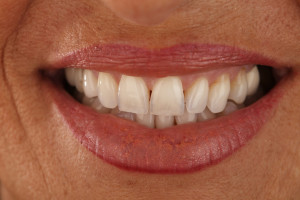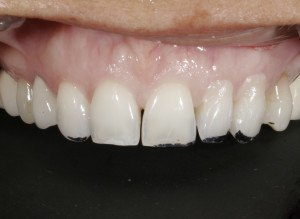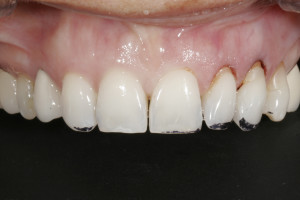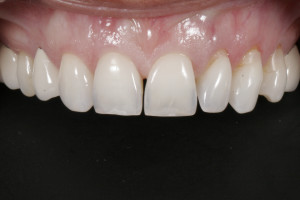Tools for Achieving Ideal Gingival Architecture
By Dr. Jason Olitsky
A critical component in the aesthetics of every restorative case is gingival architecture. It is a rare case that does not require any gingival height changes. Even minor adjustments can make a huge difference in final outcomes. As tooth doctors, we tend to focus on the restorations and teeth and may ignore minor asymmetries or discrepancies.
There are several techniques I use to achieve ideal tissue heights and shapes. A diode laser is a tool I use in my practice nearly every day. However, many times tissue re-contouring requires more than just a diode laser because removing too much tissue may cause an invasion of biological width which would then necessitate an osseous change. Studies have shown that the average dimensions for the biologic width is around 3-3.4mm, although even this can vary. So my perio rule of thumb is to never place a restorative margin within less than 3mm from the crestal bone height.
I routinely refer to an awesome periodontist for periodontal esthetic cases, but many of my cases only require the soft and hard tissue contouring on one or two teeth. If the patient rejects the referral to a periodontist for traditional crown lengthening, I have few options to overcome gingival asymmetry that requires minor bone remodeling. In years past, a tool I used was an Erbium YAG laser to perform closed flapped osseous re-contouring. It was a procedure I wasn’t 100% comfortable with, because in my hands, I couldn’t tactically “feel” where I was placing that margin when utilizing the technique. There was not a positive and clear stop when cutting. I was concerned about the potential for troughing and inadvertently causing a intrabony defect.
In the right circumstances, I utilize a chisel technique for selective crown lengthening. I learned this skill from a periodontist and it requires acute attention to patient selection. This technique begins with pre esthetic treatment planning to determine which teeth need gingival contouring prior to preparation. I have found that it is best to utilize this technique for only one to three teeth, but when more teeth are needed, then the option requires an open flap surgery. This technique contraindicated for: more than three teeth or thick biotypes. I prefer to carry out my crown lengthening procedures at least a few weeks before preparing the teeth for their provisional restorations and final impressing. This usually ends up being the appointment where I complete the records for the laboratory diagnostic wax-up. This gives the soft tissue enough time to heal and provide a more stable tissue for final restorations. As in the case you see below, I placed provisionals after 3 weeks and commonly allow tissue to mature typically 6-8 weeks.
#smilestories
The patient presented for a smile makeover. She had an incisal edge cant and a gingival margin cant that needed improvement while planning the new incisal edge positions of the teeth. At the diagnostics appointment, the teeth were marked as planned in pre-treatment esthetic analysis, by darkening out the incisal edges with a black Sharpie to their new incisal location and placing flowable to the new planned gingival margins on the two teeth #10 and 11.
The patient was anesthetized and an explorer was used to outline the new gingival margin. A diode was then used to remove the excessive soft tissue to the new out line of the gingival margin. A perio probe was then used to sound to bone and a chisel Hu-Friedy CKN1/26 and was used to re establish biologic width.
Three weeks later the patient returned for prep and provisionalization of the teeth for ceramic veneers.
This post op image is a few months after treatment.

The tissue symmetry is closer to ideal and the tooth lengths are more in harmony with the contralateral side after shortening the incisal edges and lifting the gingival margins of the two teeth.
While this technique is not one I use for every crown lengthening procedure, it is certainly another tool in my box to achieve ideal aesthetics, predictably.
For more information on practical live patient aesthetic instruction, join Dr. Jason Olitsky for Anterior Aesthetics Live, a unique over-the-shoulder experience March 11,12th in Miami, FL or October 14, 15th in Englewood Cliffs, NJ.







